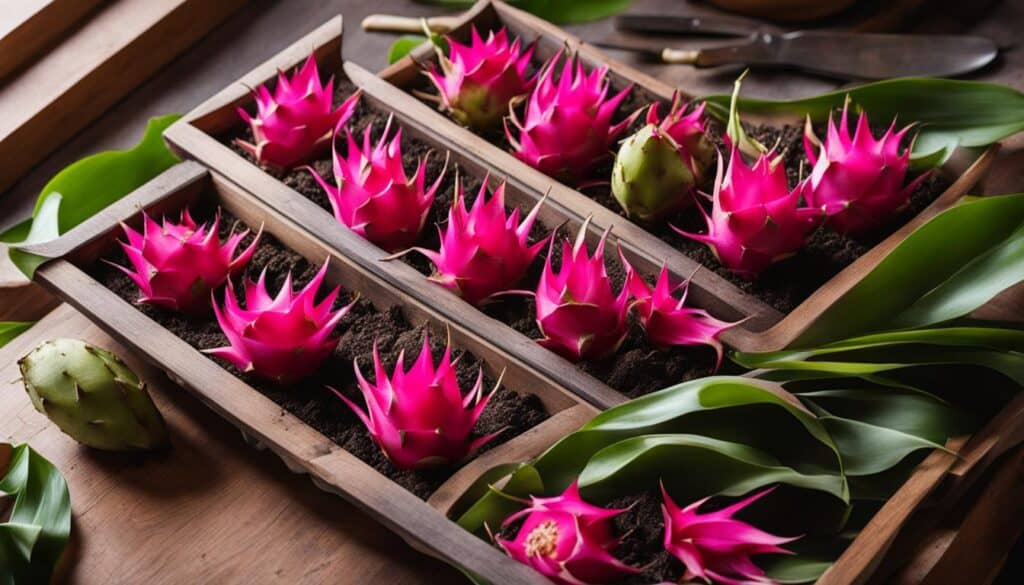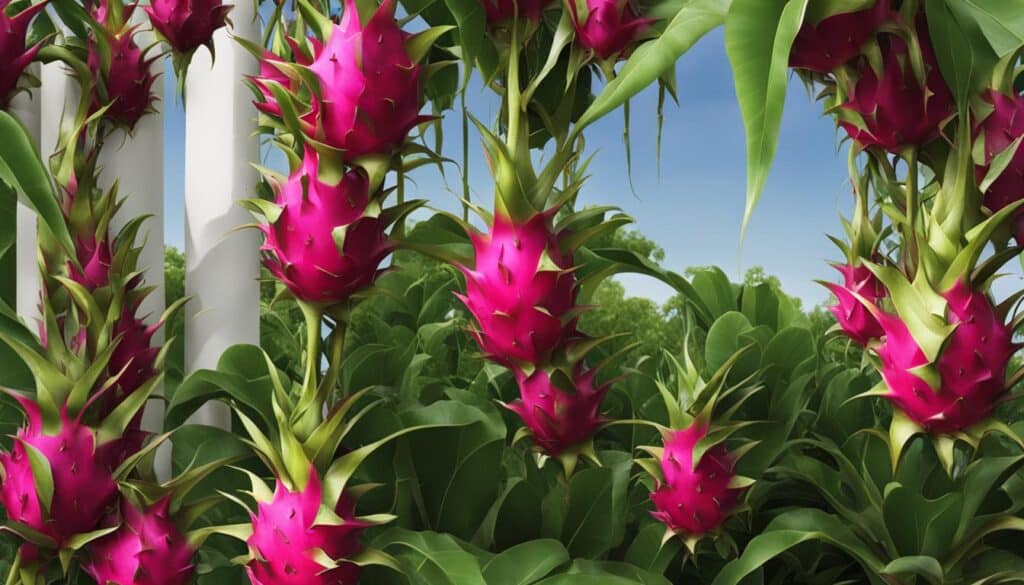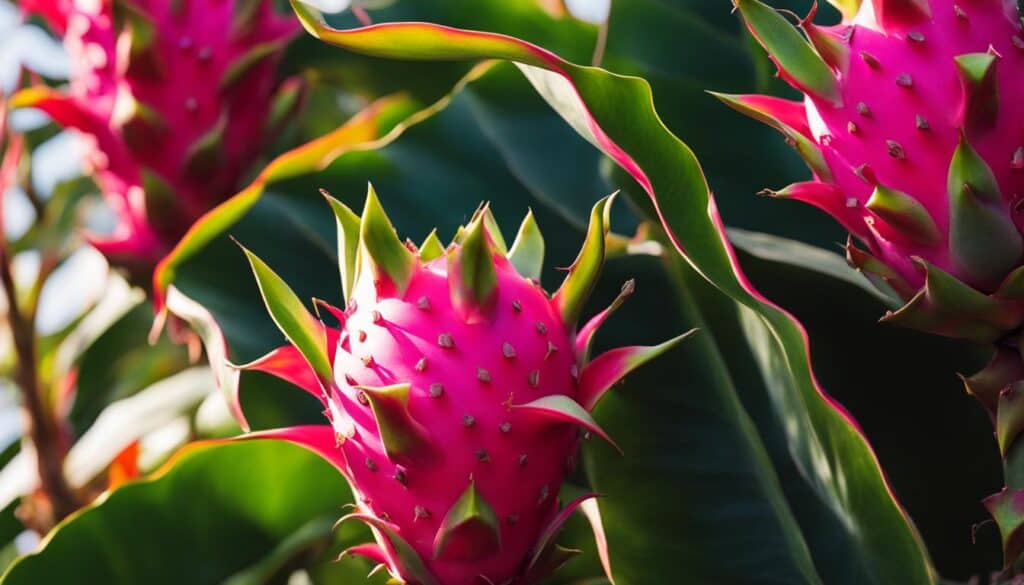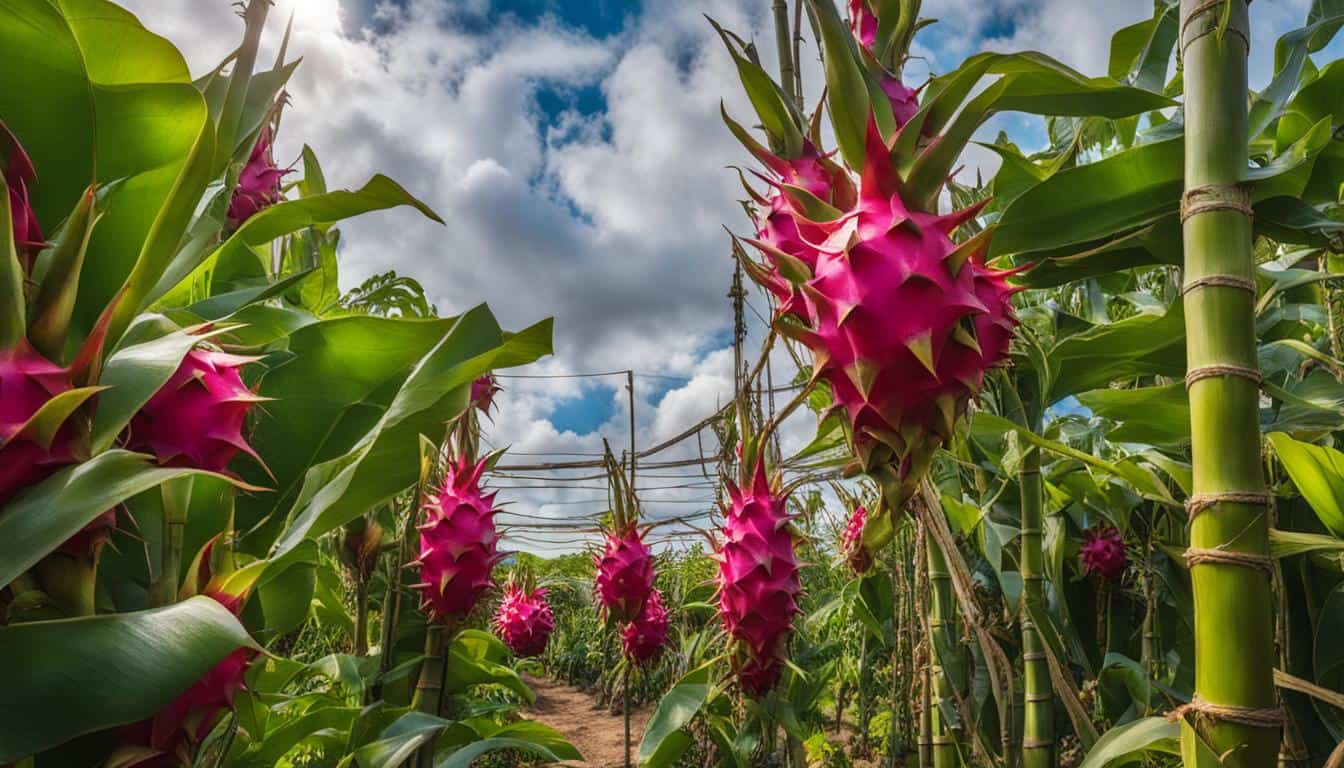Welcome to my guide on growing and cultivating dragon fruit plants! Whether you’re a seasoned gardener or a beginner, this article will provide you with valuable information on how to support the healthy growth of your dragon fruit. From understanding the different stages of growth to choosing the right variety, we’ve got you covered. Let’s dive in!
Key Takeaways:
- Dragon fruit plants go through various growth stages, including vegetative growth, reproductive development, and fruit maturation.
- They can be grown from seeds, cuttings, transplants, or tissue culture.
- Dragon fruit plants thrive in sunny or partly shaded locations with warm temperatures between 65-80°F.
- They prefer well-draining soil with a pH ideal for succulents or cacti.
- Regular watering, fertilization, pruning, and protection from pests and diseases are essential for their optimal growth.
Planting Dragon Fruit Seeds: A Step-by-Step Guide
If you’re looking to grow dragon fruit from seeds, follow this step-by-step guide to ensure successful germination and healthy plant growth.
Step 1: Extract and Prepare the Seeds
Begin by extracting the seeds from a ripe dragon fruit. Cut the fruit open and scoop out the pulp, separating the seeds from the flesh. Rinse the seeds thoroughly to remove any remaining pulp or debris. Allow the seeds to dry completely before proceeding to the next step.
Step 2: Germinate the Seeds
Fill a small container with a well-draining potting mix and lightly moisten it. Place the dragon fruit seeds on the surface of the soil, spacing them out evenly. Gently press the seeds into the soil, ensuring they are in contact with the moistened mix. Cover the container with a plastic wrap or place it in a propagator to create a warm and humid environment for germination. Keep the soil consistently moist but not waterlogged.
Step 3: Transplant the Seedlings
Once the seeds have germinated and the seedlings have developed a couple of true leaves, it’s time to transplant them into individual pots. Choose containers with drainage holes and fill them with a well-draining cactus or succulent mix. Carefully remove the seedlings from the germination container, preserving as much of the root system as possible. Plant each seedling in its new pot, ensuring the soil is evenly moist but not saturated. Place the pots in a location with bright, indirect light.
Step 4: Provide Proper Maintenance and Care
As your dragon fruit plants grow, they will require proper maintenance to thrive. Support their vertical growth by providing a trellis or support system. Regularly stake and secure the main stem to help it grow upright. Prune any dead or diseased branches as needed to promote healthy growth. Fertilize the plants with a balanced organic fertilizer every few months, following the package instructions. Mulch the soil around the plants to retain moisture and suppress weed growth. Keep an eye out for pests and diseases, and address them promptly with appropriate organic treatments.
By following these steps and providing the necessary care, you can successfully grow dragon fruit from seeds and enjoy the fruits of your labor.
Growing Dragon Fruit from Cuttings: A Comprehensive Guide

Dragon fruit cuttings are a popular method of propagating this unique and exotic fruit. It offers a straightforward way to grow dragon fruit plants, and with proper care, these cuttings can develop into robust and productive plants. In this comprehensive guide, I will provide you with step-by-step instructions on how to grow dragon fruit from cuttings, ensuring a successful propagation process.
First and foremost, it’s crucial to select healthy stems for the cuttings. Look for mature stems that are at least one year old, as they tend to root more effectively. Using clean and sharp pruning shears, make a clean cut just above a stem segment or “node.” This is where the roots will eventually form.
Next, allow the wound on the cutting to dry and callous over. This step is crucial as it helps prevent rotting and infection. It typically takes around one to two weeks for the wound to heal. Once the cutting is calloused, it’s time to plant it in a well-draining mix. A mixture of cactus or succulent soil, perlite, and sand works well.
Remember, when planting the cutting, it’s essential to bury it at least one to two inches deep to provide stability and encourage root development.
Place the potted cutting in an ideal spot that receives bright, indirect sunlight. Avoid direct sunlight during the hottest hours of the day, as it can scorch the cutting. Water the cutting sparingly, allowing the soil to dry out slightly between waterings. Overwatering can lead to root rot and other issues.
| Dragon Fruit Cuttings[1] | Recommended Soil Mix | Light Requirements | Watering |
|---|---|---|---|
| Healthy, mature stems | Cactus or succulent soil, perlite, and sand | Bright, indirect sunlight | Sparingly, allowing soil to dry between waterings |
As the cutting begins to establish its root system, it’s important to monitor its growth and adjust care accordingly. Once the roots have developed, which can take several weeks to a few months, it’s time to transplant the cutting into a larger pot or directly into the ground, depending on your growing conditions.
Remember, dragon fruit plants grown from cuttings require the same maintenance and care as those grown from seeds. This includes regular pruning to remove dead or diseased branches, providing support for vertical growth, and protecting the plants from pests and diseases.
By following these steps, you can successfully grow dragon fruit from cuttings and enjoy the beauty and delicious taste of this exotic fruit right in your own backyard.
Ideal Growing Conditions for Dragon Fruit Plants
When it comes to cultivating dragon fruit plants, providing the ideal growing conditions is key to their success. These unique and exotic plants thrive in specific environments that mimic their native habitat. To ensure optimal growth and fruit production, here are the essential factors to consider:
Light Requirements
Dragon fruit plants require abundant sunlight to thrive. They should be placed in locations that receive at least six hours of direct sunlight per day. However, in hotter regions, partial shade during the hottest part of the day can help protect the plants from scorching heat.
Temperature
Dragon fruit plants prefer warm temperatures between 65-80°F (18-27°C). They can tolerate slightly cooler temperatures but are sensitive to frost. Therefore, it is important to protect the plants during freezing temperatures by covering them or bringing them indoors.
Water Requirements
Unlike many other fruit-bearing plants, dragon fruit plants are not water-demanding. Overwatering can lead to root rot and other issues. It is important to water them sparingly and only when the top few inches of soil are dry. In arid and semi-arid climates, they can withstand drought conditions, making them a suitable choice for water-wise gardening.
Soil
The right soil composition is essential for the successful growth of dragon fruit plants. They thrive in well-draining soil with a pH level ideal for succulents or cacti. A mixture of sandy soil with organic matter can provide the necessary drainage and nutrients for the plants to flourish.
| Light Requirements | Temperature | Water Requirements | Soil |
|---|---|---|---|
| At least six hours of direct sunlight per day | 65-80°F (18-27°C) | Sparingly watered, only when the top few inches of soil are dry | Well-draining soil with a pH ideal for succulents or cacti |
By providing dragon fruit plants with the ideal growing conditions of ample sunlight, suitable temperature range, appropriate water levels, and well-draining soil, you can ensure their healthy growth and bountiful harvest.
Training and Pruning Dragon Fruit Plants

Proper Techniques for Supporting Growth
When it comes to cultivating dragon fruit plants, training and pruning are essential aspects of their care. These practices not only help to maintain the plant’s shape and size but also encourage healthy growth and maximize fruit production. To effectively train and prune dragon fruit plants, it is crucial to understand the techniques involved and the support systems needed.
Training dragon fruit plants involves providing a proper support system for their vertical growth. This can be achieved by using a trellis, fence, or even a sturdy stake. As the plant develops, the main stem should be gently tied to the support structure, ensuring it remains upright and stable. This helps to prevent the sprawling growth pattern of dragon fruit plants and promotes more efficient use of space in the garden or growing area.
Pruning is another crucial aspect of dragon fruit plant care. Regular pruning helps to remove dead, damaged, or diseased branches, which can hinder the plant’s overall growth and productivity. Additionally, pruning promotes the development of new branches and encourages a bushier growth habit. By pinching off the growing tips, you can stimulate branching and increase the number of flower buds, resulting in a higher yield of delicious dragon fruits.
Benefits of Training and Pruning
Training and pruning dragon fruit plants offer numerous benefits that contribute to their overall health and productivity. By providing a support system, you can prevent the plants from sprawling on the ground, reducing the risk of damage from pests, diseases, and rot. The vertical growth also allows for better air circulation and sunlight exposure, which are vital for optimal plant growth.
Pruning, on the other hand, helps to maintain the plant’s size, preventing it from becoming overly large and difficult to manage. It also facilitates easier harvest and maintenance, as the fruits are more accessible and the plant’s overall shape is more controlled. Moreover, pruning promotes the development of new branches, which can lead to more flower buds and, ultimately, a higher yield of dragon fruits.
Training and Pruning Tips
When training and pruning dragon fruit plants, it is essential to follow a few key tips for success. Firstly, ensure that the support system is sturdy and able to withstand the weight of the growing plant. It should be securely anchored in the ground or to a structure to prevent any toppling or bending.
When pruning, use sharp and clean tools to make precise cuts. Remove any dead or diseased branches, making the cuts just above a healthy node or bud. To promote branching, pinch off the growing tips of the branches, encouraging the emergence of new shoots.
Regularly monitor the plant’s growth and adjust the support system as needed. As the plant grows taller, additional ties or clips may be required to keep the main stem in an upright position. Finally, remember to provide adequate water and nutrients to support the plant’s health and growth throughout its training and pruning process.
Harvesting and Storing Dragon Fruit
Harvesting dragon fruit is an exciting and rewarding step in the cultivation process. To ensure the best flavor and texture, it’s important to know when and how to properly harvest these delicious fruits. Dragon fruits are ready to harvest when they can be easily twisted off the plant. They should be picked when fully ripe, as they do not continue to ripen once harvested. The vibrant colors and firmness of the fruit are good indicators of ripeness.
When harvesting, it’s recommended to wear gloves to protect your hands from the spines on the fruit and the plant. To remove the fruit, simply twist it gently until it detaches from the stem. Be careful not to bruise or drop the fruit, as it can easily get damaged.
“When harvesting dragon fruit, it’s important to handle the fruit with care to avoid any damage or bruises. Twisting the fruit off the stem is a gentle and effective method.”
Once harvested, dragon fruits can be stored in the refrigerator for up to a week. It’s best to store them in a perforated plastic bag to maintain proper moisture levels and prevent them from drying out. Avoid washing the fruit before storing, as excess moisture can lead to spoilage.
If you have an abundance of dragon fruits and want to store them for a longer period, consider freezing or drying them. To freeze dragon fruit, simply cut the fruit into slices or cubes and place them in a freezer-safe bag. Frozen dragon fruit can be used in smoothies, desserts, or enjoyed as a refreshing frozen snack. To dry dragon fruit, slice it into thin pieces and place them on a baking sheet lined with parchment paper. Dry the slices in a dehydrator or oven at a low temperature until they become crispy. Dried dragon fruit can be eaten as a healthy snack or used in various recipes.
| Harvesting Tips | Storage Tips |
|---|---|
| Harvest dragon fruits when they can be easily twisted off the plant. | Store dragon fruits in a perforated plastic bag in the refrigerator. |
| Handle the fruit with care to avoid any damage or bruises. | Avoid washing the fruit before storing to prevent excess moisture. |
| Wear gloves to protect your hands from the spines on the fruit and the plant. | Freeze dragon fruit for long-term storage or dry it for a crispy snack. |
Common Problems and Solutions in Dragon Fruit Cultivation
Dragon fruit cultivation is not without its challenges, as growers may encounter various problems that can affect the health and productivity of their plants. To ensure successful cultivation, it is essential to be aware of these common issues and have effective solutions at hand.
Pests and Diseases
One of the primary concerns in dragon fruit cultivation is the presence of pests and diseases. Common pests that can affect dragon fruit plants include mealybugs and scale insects. These pests feed on the plant’s sap and can cause wilting, yellowing of leaves, and stunted growth. To control these pests, regular inspection and the use of organic insecticides or biological control methods can be employed.
Dragon fruit plants are also susceptible to various diseases, such as fungal infections and bacterial rot. Fungal diseases, like anthracnose and stem canker, can cause brown spots on the stems and fruits, leading to decay. Bacterial rot, on the other hand, can result in soft and watery tissues, making the fruits inedible. Proper sanitation, good airflow, and the use of fungicides can help prevent and manage these diseases.
Poor Fruit Production
In some cases, dragon fruit plants may exhibit poor fruit production, which can be attributed to several factors. Insufficient pollination, inadequate sunlight exposure, or imbalanced fertilization can all contribute to low fruit yield. To address these issues, growers can manually pollinate the flowers using a small brush or implement a support system that maximizes sunlight exposure. Additionally, regular application of a balanced organic fertilizer can promote healthy plant growth and enhance fruit production.
Environmental Factors
Environmental factors such as extreme temperatures and insufficient water supply can also impact dragon fruit cultivation. Excessive heat or cold can cause stress to the plants, affecting their growth and fruiting. Inadequate water availability can lead to dehydration and hinder proper nutrient uptake. To mitigate these risks, it is crucial to provide the plants with adequate shade, protect them from frost or heatwaves, and ensure consistent watering that allows the soil to dry out between waterings.
| Problem | Solution |
|---|---|
| Pests (mealybugs, scale insects) | Regular inspection and use of organic insecticides or biological control methods |
| Diseases (fungal infections, bacterial rot) | Proper sanitation, good airflow, and use of fungicides |
| Poor Fruit Production | Manual pollination, maximizing sunlight exposure, and regular balanced organic fertilization |
| Environmental Factors (extreme temperatures, insufficient water supply) | Providing shade, protection from extreme weather, and consistent watering |
By being aware of these common problems and their solutions, dragon fruit growers can effectively address any challenges that arise, promote healthy plant growth, and maximize fruit production. Implementing proper care and maintenance practices will ultimately lead to a thriving dragon fruit cultivation.
Choosing the Right Dragon Fruit Variety
When it comes to choosing the right dragon fruit variety, there are a few options to consider. One of the most popular choices is the Hylocereus undatus, which is known for its vibrant red flesh. This variety offers a sweet and refreshing flavor, making it a favorite among dragon fruit enthusiasts. The red flesh dragon fruit is not only visually appealing but also packed with essential nutrients, antioxidants, and fiber.
Alternatively, you may also opt for the Hylocereus costaricensis, which features white flesh. This variety has a slightly milder flavor compared to its red-fleshed counterpart, but it still offers a deliciously sweet taste. White flesh dragon fruit is rich in vitamin C and other beneficial compounds that support overall health and wellness.
Both red and white flesh dragon fruit varieties are equally nutritious and can be enjoyed in a variety of ways. Whether you prefer the vibrant red or the subtle elegance of white flesh, either choice will provide a delightful and healthy addition to your diet.
| Dragon Fruit Variety | Fruit Color | Flavor | Nutritional Benefits |
|---|---|---|---|
| Hylocereus undatus | Red | Sweet and refreshing | Rich in antioxidants, fiber, and essential nutrients |
| Hylocereus costaricensis | White | Milder, subtly sweet | High in vitamin C and other beneficial compounds |
Regardless of the variety you choose, dragon fruit is a versatile fruit that can be enjoyed on its own, added to smoothies, salads, or even incorporated into desserts. Experiment with different recipes and preparations to fully experience the unique flavors and health benefits of dragon fruit.
Caring for Dragon Fruit Plants

When it comes to caring for dragon fruit plants, there are a few key aspects to keep in mind. Proper watering, fertilization, pruning, and protection measures are essential for their healthy growth and abundant fruit production.
Watering:
Dragon fruit plants are not water-demanding, but they still require regular and consistent watering. It is important to strike a balance and avoid over-watering, as excessive moisture can lead to root rot. As a general guideline, water the plants deeply once a week, allowing the soil to dry out in between watering sessions.
Fertilization:
Providing your dragon fruit plants with proper nutrients is crucial for their overall health and development. Use a balanced organic fertilizer formulated for cacti and succulents. Apply the fertilizer every two to three months during the growing season, following the manufacturer’s instructions. Be careful not to over-fertilize, as it can result in excessive vegetative growth at the expense of fruit production.
Pruning:
Pruning is an important aspect of dragon fruit plant care. Regular pruning helps maintain the plant’s shape, remove dead or diseased branches, and promote new growth and fruit formation. Remove any damaged or weak branches, as well as excessive growth that can hinder air circulation. Pruning can be done during the dormant season or after fruit harvest.
Protection:
Protecting your dragon fruit plants from pests, diseases, and extreme weather conditions is vital for their well-being. Keep an eye out for common pests such as mealybugs and scale insects, and take appropriate measures to control infestations. Provide shade during hot summer months to protect the plants from sunburn. In colder climates, protect the plants from frost by covering them or moving them indoors during freezing temperatures.
By following these guidelines for caring for dragon fruit plants, you can ensure their optimal growth and enjoy a bountiful harvest of delicious and nutritious fruits!
Planting and Harvesting Calendar for Dragon Fruit
When it comes to growing dragon fruit, timing is crucial to ensure a successful harvest. Understanding the planting and harvesting calendar for dragon fruit can help you maximize your yield and enjoy the fruits of your labor.
Dragon fruit plants can be planted year-round in tropical climates, where the temperatures remain consistently warm. However, in regions with distinct seasons and varying climates, it is important to consider the right time for planting and harvesting based on local conditions.
To help you plan your dragon fruit cultivation, here is a general planting and harvesting calendar:
| Region | Planting Season | Harvesting Season |
|---|---|---|
| Tropical Climates | Year-round | Year-round |
| Subtropical Climates | Spring | Summer, Fall |
| Mediterranean Climates | Spring | Summer, Fall |
| Semi-Arid Climates | Spring | Summer, Fall |
| Temperate Climates | Spring | Summer, Fall |
| Cold Climates | Spring | Summer |
Note: The above calendar is a general guide, and it’s essential to consider the specific climate and conditions in your region. Consult with local experts or experienced growers for more precise information.
By following the planting and harvesting calendar for dragon fruit, you can ensure that your plants receive the optimal conditions for growth and fruit production. Happy cultivating!
Conclusion
In summary, growing dragon fruit can be a rewarding experience that yields healthy and delicious fruits. By providing the proper support, such as trellises or support systems for vertical growth, you can ensure the optimal development of your dragon fruit plants.
Whether you choose to grow dragon fruit from seeds or cuttings, it is essential to follow the recommended guidelines for planting, care, and maintenance. This includes providing the right light conditions, temperature, and well-draining soil with the ideal pH. Regular watering, fertilization, pruning, and protection from pests and diseases will also contribute to the successful cultivation of your dragon fruit plants.
Harvesting dragon fruit at the right time, when fully ripe, will ensure the best flavor and quality. You can store freshly harvested dragon fruits in the refrigerator for up to a week or choose to freeze or dry them for long-term storage.
With proper care and attention to detail, you can enjoy a bountiful harvest of dragon fruits while adding a unique and tropical touch to your garden or indoor space.
FAQ
What are the different stages of dragon fruit plant growth?
Dragon fruit plants go through vegetative growth, reproductive development, and fruit maturation stages.
How can dragon fruit be grown?
Dragon fruit can be grown from seeds, cuttings, transplants, or tissue culture.
What are the ideal growing conditions for dragon fruit plants?
Dragon fruit plants thrive in sunny locations or partly shaded spots and prefer warm temperatures between 65-80°F. They can be grown in arid and semi-arid climates and require well-draining soil with an ideal pH for succulents or cacti.
How do you grow dragon fruit from seeds?
To grow dragon fruit from seeds, you need to extract and prepare the seeds, germinate them, transplant the seedlings, and provide proper maintenance, staking, pruning, fertilization, mulching, and care for pests and diseases.
What is the process of growing dragon fruit from cuttings?
Growing dragon fruit from cuttings involves choosing healthy stems, allowing the wound to heal, planting in a well-draining mix, placing in an ideal spot, and transplanting. The cuttings also require the same maintenance and care as those grown from seeds.
How much sunlight do dragon fruit plants need?
Dragon fruit plants thrive in full sun or partial shade and require at least 6 hours of direct sunlight per day.
When is the best time to harvest dragon fruit?
Dragon fruits are ready to harvest when they can be easily twisted off the plant and should be picked when fully ripe.
What are some common problems in dragon fruit cultivation?
Dragon fruit plants can be affected by poor fruit production, pests such as mealybugs and scale insects, sunburn, frost damage, and nutrient deficiencies.
How do you care for dragon fruit plants?
Caring for dragon fruit plants involves regular watering, fertilization with a balanced organic fertilizer, pruning to promote healthy growth and fruit production, and protection from pests, diseases, and frost.
How do you choose the right dragon fruit variety?
When choosing a dragon fruit variety, consider the options of Hylocereus undatus with red flesh and Hylocereus costaricensis with white flesh. Each variety has its own flavor, aroma, and nutritional characteristics.
Can dragon fruit be planted and harvested year-round?
In tropical climates, dragon fruit can be planted year-round. In other regions, it is important to consider the right time for planting and harvesting based on the local climate and conditions.





Leave a Reply